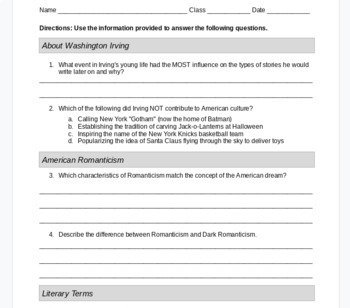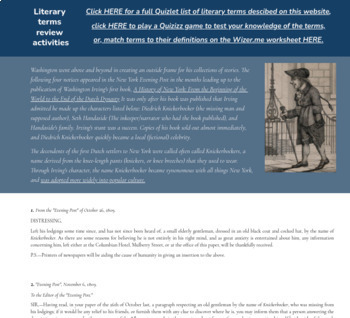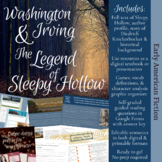Washington Irving Bio/Author Profile Study-His Biography & Historical Background
- PDF
- Internet Activities
What educators are saying
Also included in
- This unit includes a complete bundle of the story of the Legend of Sleepy Hollow, Washington Irving's biography/author profile, and background information on the character-narrator Diedrich Knickerbocker The unit can can take between 1 and 2 weeks to complete, depending on if you have block or perioPrice $9.00Original Price $12.00Save $3.00
Description
This Washington Irving lesson includes the historical background and author study/biography, and can be used as an introduction to any of Irving's short stories, including The Legend of Sleepy Hollow, Rip Van Winkle, or The Devil and Tom Walker.
The lesson includes historical context and bio of Washington Irving to help students better understand the time period in which Irving's short stories were written, and it explains the features of both Romanticism and Dark Romanticism. It also introduces Irving’s character-narrator Diedrich Knickerbocker using the newspaper notices on Knickerbocker's "disappearance" and excerpts from Irving's first book, A History of New York. Furthermore, it prepares students for Irving's use of satire, folklore, and character development.
It can take between 1 and 2 days to complete, depending on how much time you have in class and which options you choose to incorporate.
You can keep the lesson completely digital, go paper-based, or opt for a combination of the two. It can be used in a flipped classroom style, for sub-plans, or for e-learning.
Materials Include:
- A website with background information and author bio on Washington Irving and this time period in American history, as well as descriptions of Romantic and Dark Romantic genres of literature. The website can be used in place of a slide presentation in class or shared with students for independent, self-paced learning.
- The second half of the website details Irving's scheme to "tease" the release of his first book by placing missing person notices in a local newspaper, and an excerpt from A History of New York describing his most famous character-narrator, Diedrich Knickerbocker - Note that Knickerbocker is the character that Irving uses to narrate all three stories, The Legend of Sleepy Hollow, Rip Van Winkle, and The Devil and Tom Walker.
- A Google Form and printable worksheet with reading comprehension and higher-thinking analysis questions which require students to use evidence from the text to support their answers
- A link to a fully printable work packet for students if you are not 1-1, or for those without internet access at home
- Answer key
- Links to a vocabulary list of literary terms discussed on the website, with optional games to play in class.
Everything is ready to go. Just print or post to your online classroom and you’re set. The materials are copied to your own Google drive, so you also have the option to edit or adapt them to suit your students’ needs if you choose to do so.
Goals for the lesson:
1. For students to gain an understanding of the author, Washington Irving, the time period he was writing, and his influence on American culture and society
2. For students to understand the features of Romanticism and Dark Romanticism and how they developed, in order to later try and classify Irving’s writing.
3. For students to recognize satire, frame stories, types of narrators, the point of view from which a story is told, methods of characterization, and apply these ideas in an analysis of one of Irving’s stories.
4. For students to have the tools necessary to identify the theme of a work by recognizing character flaws and whether or not the characters learned or developed as a result of the story.
Literary terms covered:
Pseudonym
Satire
Forms of irony
Frame story
Unreliable narrator
Characterization
Character flaw
Theme
Romanticism
Dark Romanticism






